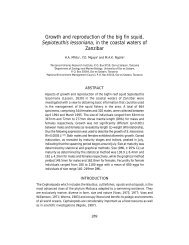gpa_east_africa_case.. - GRID Africa GeoPortal - UNEP
gpa_east_africa_case.. - GRID Africa GeoPortal - UNEP
gpa_east_africa_case.. - GRID Africa GeoPortal - UNEP
You also want an ePaper? Increase the reach of your titles
YUMPU automatically turns print PDFs into web optimized ePapers that Google loves.
Mtoni and Pugu. Existing lakes include Luhanga, Makurumula, Msimbazi River and Tandale.No data is available for the actual catch. Marine fisheries employs more than 3000 men invillages such as Mbweni, Ununio, Kunduchi, Mtongani, Kawe, Kimbiji, Gezaulole, Mjimwemaetc. Fish catch in 1995 was about 5,000 MT. The main types of fishnets are gillnets, sharknets, sieve nets, hand lines and traps. Beach seine is practised mostly by small-scalefishermen with canoes or small boats who fish in shallow waters. The demand for fish in thecity of DSM exceeds local supply. Fish is imported from Lake Victoria, Mtera Dam, Ifakara,Lake Tanganyika and Nyumbaya Mungu, while local fish is also exported. Fish handlingmethods are very poor. At landing stations fish are thrown on sand at the beach where theyare gutted and de-scaled, the offal is left on the beach and decompose hence becomes asource of pollution. Due to shortage of fresh water at these stations, fish are washed withseawater, catches pile on the sand under high temperatures, increasing the decompositionrate. Effects to fish due to pollution in marine are expected. Through food chain processtransferring of toxic pollutants to consumers is highly possible. Although various surveys havebeen carried out to determine the quality and quantity of fish resources, the impacts onfisheries from land based pollutants and their costs have not been studies within theframework of a cost-benefit analysis.Mangroves. There are 2,266 ha of mangrove forests distributed throughout the coastal area.They serve as a nursery for many species and provide physical habitat for numerous fish,crustacean and many varieties of important species and they are a threatened resource. Theyare cut and used by local people for construction, export, firewood, charcoal making, boatbuilding and salt making and release land for rice farms. Most of the mangrove tree cutting isunregulated and is carried out without permits although mangrove forests are gazzetted asforest reserves.Distribution of mangroves by districtDistrict Location Area (ha)Temeke Mbezi river 570.3Mbuyuni 476.7Shugu/Mtandika 270.8Ras Dege 245.0Mbwamaji 29.6Mjimwema 80.9Mtoni 378.4Kinondoni Kunduchi Creek 68.7Ras Kiromoni 20.2Mbweni area 100.6Ilala Msimbazi River 25.3Source: An aquamarine profile of Dar es Salaam region, March 1995 by NEMCMarine ecosystem (coral reefs, sea grasses and other marine life). Untreated municipaland industrial wastewater discharges, runoff and sediments from rivers ultimately reach thecoastal and marine environment. The degradation of the marine environment is often "out ofsight" and responsibility is evaded on the assumption that the "sink" capacity of theenvironment will absorb the impact. Coastal area predominant in Coraline Islands, includingMbudya Island, Bongoyo Island, Sinda Island, Fungu Yasini Island, Pangavini Island andMakatumbe Island. These islands in addition to their diversity, provide protection to the DSMcoastline. Degradation from land based pollutants have diverse ecological and productivityimpacts that are not valued in cost-benefit terms due to conceptual and measurementdifficulties. It is now increasingly recognised that at l<strong>east</strong> part of the most important indirectimpacts on the marine environment, other than the direct impacts on fisheries, can beestimated through the foregone tourism and recreation opportunities. Coastal lagoons, mudflats and shallow mud-silt bottoms in protected bays and estuaries associated with coral reefsform a good habitat for sea grass and fish species. Degradation of habitats creates directproduction changes and indirect losses to the "existence or non-use" benefits from marineresource quality. Apart from land-based pollutants, bad fishing practices such as use ofbottom traps, beach seines and explosive fishing techniques, cause considerable damage tofish, bottom flora and fauna and coral reefs and sea grasses.Final Draft Report – Cost Benefit Case StudiesGPA Strategic Action Plan on Sewage, October, 200086



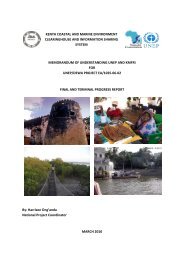
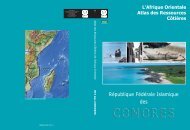
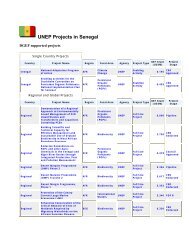

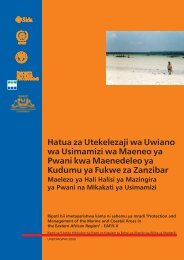
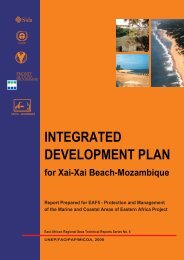
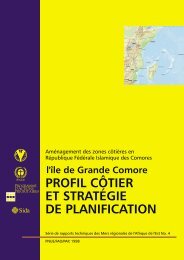
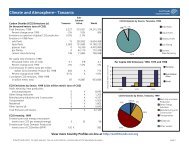

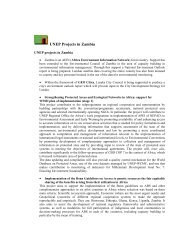
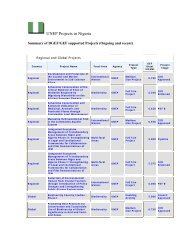
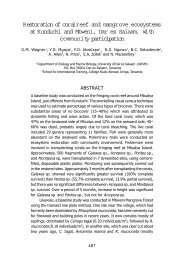
![Please Click to download [English] - GRID Africa GeoPortal - UNEP](https://img.yumpu.com/30633391/1/184x260/please-click-to-download-english-grid-africa-geoportal-unep.jpg?quality=85)
